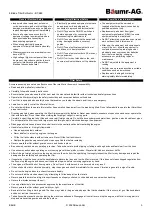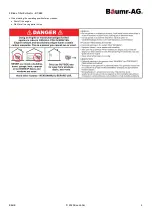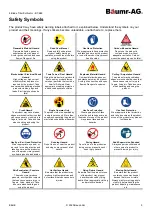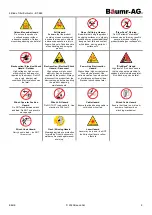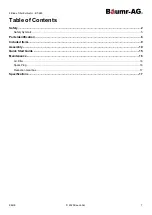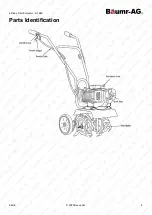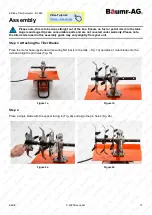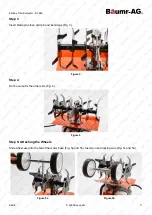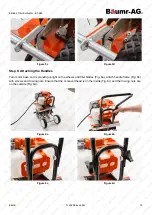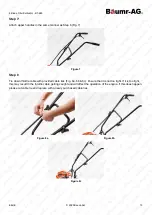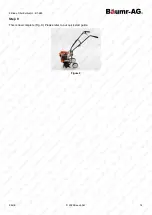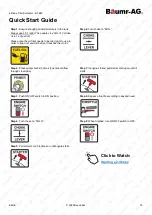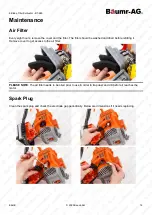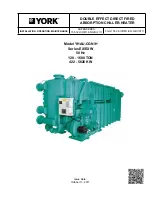
6 Blade Tiller/Cultivator - BT-689
E&OE
© 2020 Baumr-AG
3
General Electrical Safety
•
Inspect electrical equipment, extension
cords, power bars, and electrical fittings for
damage or wear before each use. Repair or
replace damaged equipment immediately.
•
Ensure all power sources conform to
equipment voltage requirements and are
disconnected before connecting or
disconnecting equipment.
•
When wiring electrically powered
equipment, follow all electrical and safety
codes.
•
Wherever possible, use a residual current
device (RCD).
•
High voltage / high current power lines may
be present. Use extreme caution to avoid
contact or interference with power lines.
Electrical shock can be fatal.
General Electrical Safety
•
Electrically grounded equipment must have
an approved cord and plug and be
connected to a grounded electrical outlet.
•
Do NOT bypass the ON/OFF switch and
operate equipment by connecting and
disconnecting the electrical cord.
•
Do NOT use equipment that has exposed
wiring, damaged switches, covers or
guards.
•
Do NOT use electrical equipment in wet
conditions or in damp locations.
•
Do NOT use electrical cords to lift, move or
carry equipment.
•
Do NOT coil or knot electrical cords, and
ensure electrical cords are not trip hazards.
General Service Information
•
The equipment must be serviced or
repaired at authorised service centres by
qualified personnel only.
•
Replacement parts must be original
equipment manufacturer (OEM) to ensure
equipment safety is maintained.
•
Do NOT attempt any maintenance or repair
work not described in this manual.
•
After use, the equipment and components
may still be hot – allow the equipment to
cool and disconnect spark plugs and/or
electrical power sources and/or batteries
from it before adjusting, changing
accessories or performing repair or
maintenance.
•
Do NOT adjust while the equipment is
running.
•
Perform service related activities in suitable
conditions, such as a workshop.
•
Replace worn, damaged or missing
warning/safety labels immediately.
Tiller Safety
Accurate assembly and safe and effective use of the rototiller is the owner’s responsibility.
•
Read and follow all safety instructions.
•
Carefully follow all assembly instructions.
•
Ensure that anyone who uses the tiller must read the manual and be familiar with all controls and safety precautions.
•
Operate the tiller according to the safety instructions and recommendations outlined here.
•
Your tiller is equipped with a safety device that enables you to stop the wheels and tines in an emergency.
•
Learn how to safely control the tiller at all times.
•
Do not allow children to operate this rototiller. Keep small children away from the area being tilled. Do not allow adults to operate the tiller without
proper instruction.
•
Dress appropriately when operating the tiller. Always wear sturdy footwear. Never wear sandals, sneakers or open shoes and never operate the
tiller with bare feet. Do not wear loose clothing that might get caught in moving parts.
•
Carefully inspect the area to be tilled and remove all foreign objects. Do not till above underground water lines, gas lines, electric cables or pipes.
Do not operate the tiller in soil with large rocks and foreign objects which can damage the equipment.
•
Disengage all clutches and leave all control levers in the neutral position before starting the engine.
•
Handle fuel with care; it is highly flammable:
•
Use an approved fuel container.
•
Never add fuel to a running engine or hot engine.
•
Fill the fuel tank outdoors with extreme care. Never fill the fuel tank indoors.
•
Replace the gasoline cap securely and clean up spilled fuel before restarting.
•
Never operate the tiller without guards, covers and hoods in place.
•
Be extremely cautious when operating in reverse. Take extra care to avoid slipping or falling, and keep hands and feet clear from the tines.
•
Use extreme caution when operating on or crossing gravel drives, walks or roads. Stay alert for hidden hazards or traffic.
•
After striking a foreign object, stop the engine, remove the wire from the spark plug, thoroughly inspect the tiller for any damage and repair the
damage before restarting and operating the tiller.
•
If vegetation clogs the tines, raise the handlebars to elevate the lines and run the tiller in reverse. If this does not clean chopped vegetation from
the tines, stop the engine and disconnect the spark plug wire before removing vegetation by hand.
•
The engine muffler will be hot from operation. Do not touch it with bare skin or a severe burn may result.
•
If the unit should start to vibrate abnormally, stop the engine and check immediately for the cause. Vibration is generally a sign of trouble.
•
Do not run the engine indoors; exhaust fumes are deadly.
•
Do not overload the machine capacity by attempting to fill too deep at too fast a rate.
•
Never operate the machine at high transport speeds on slippery surfaces. Look behind and use care when backing.
•
Never allow bystanders near the unit.
•
Use only attachments and accessories approved by the manufacturer of the tiller.
•
Never operate the tiller without good visibility or light.
•
Be careful when tilling in hard ground. The tines may catch in the ground and propel the tiller backwards. If this occurs, let go of the handlebars
and do not restrain the machine.
•
Take all possible precautions when leaving the machine unattended. Disengage all control levers, stop the engine, wait for all moving parts to
stop and make certain guards and shields in place.



